Samsung Epic 4G Review: The Fastest Android Phone
by Anand Lal Shimpi on September 6, 2010 5:28 PM EST- Posted in
- Smartphones
- Samsung
- Epic 4G
- Gadgets
- Mobile
Easily Influenced
As the manufacturer for both the NAND that goes into Apple devices and the SoC that Apple uses in the iPhone/iPad, Samsung works closer with Apple than most other smartphone vendors. I was once given a characterization of Samsung that I will never forget: this is a company that’s trying to learn as much as it can from Apple for use in its own smartphone endeavors.
There’s no better example than the Galaxy S. Unlike other vendors who have been Cupertino inspired, Samsung’s learnings are put to use almost exclusively in software. Physically, the Galaxy S is quite dissimilar from the industrial design used in Apple’s iOS products.
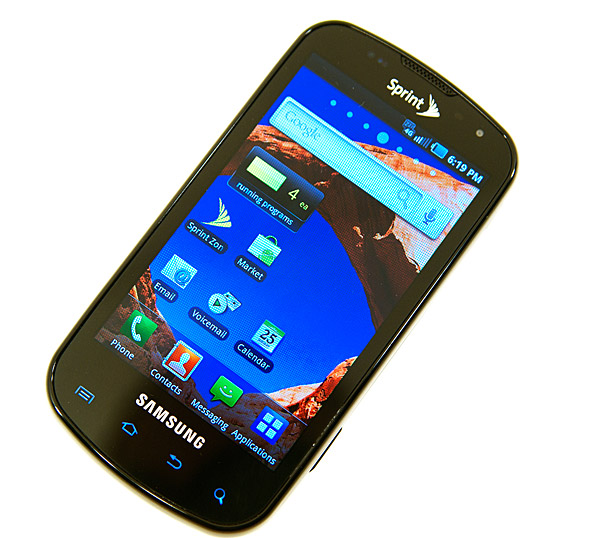
Samsung sent me the Epic 4G, a variant of the Galaxy S for use on Sprint’s network (with WiMAX support as implied by the 4G moniker). The Epic 4G has an amazingly contrasty 4” 800 x 480 Super AMOLED display. The capacitive touchscreen is backed up by a physical keyboard that slides out in landscape mode.
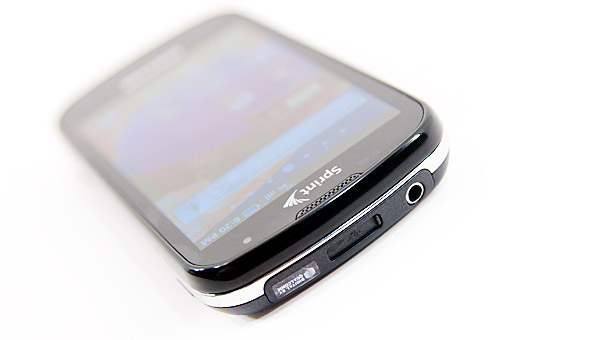
I’d say that Samsung did everything to be the most unlike Apple in the design of the Epic 4G. Along the top you have a microUSB port, but Samsung included a sliding cover to keep the pocket lint out. This adds complexity to the look of the device, but is nicely protective if you’re a bit OCD about getting lint in the crevices of your phone. The sheer location of the microUSB port is unusual as well. Most Android phones we’ve looked at have their power/sync connector at the bottom of the phone, not the top.
The power/lock button also shifts positions compared to what we’re used to. It’s on the right side, near the top on the Epic 4G.
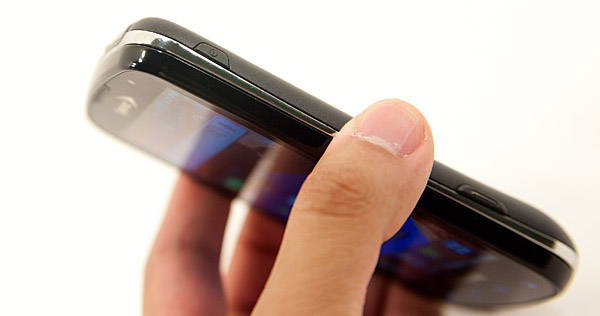
On the lower part of the right side of the phone there’s a shutter release button for the camera. There’s a volume rocker on the left side of the phone. All of the buttons on the Epic 4G have a rubbery texture to them with the exception of the shutter release button which has a metal insert surrounded by rubber.
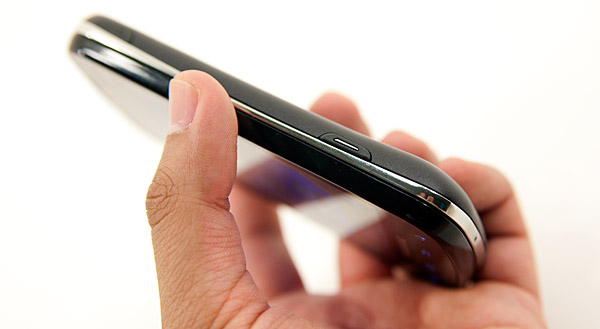
The screen slides up to reveal a landscape keyboard on the Epic 4G. The sliding mechanism is easy enough to operate with one hand and reasonably smooth. It’s not the most confidence inspiring but not terrible either.
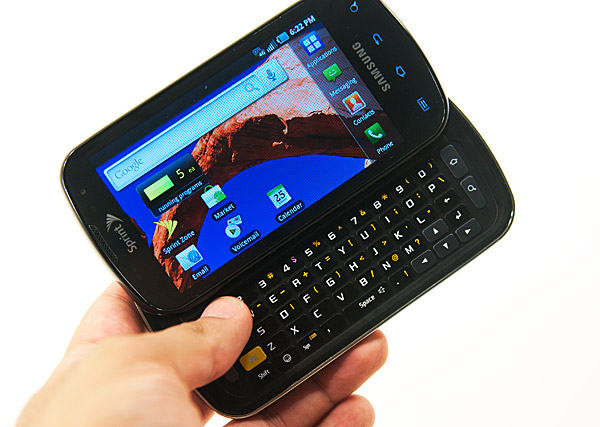
The physical keyboard itself is a nice addition for those who must absolutely have it. Samsung even duplicates the four Android keys on the keyboard itself (home, back, menu, and search) so you can exclusively use the physical keyboard for navigating the OS if you’d like. There is no scroll ball or equivalent on the Epic 4G, but the physical keyboard does have four arrow keys you can use in its stead.
The keys on the physical keyboard are fairly wide and reasonably spaced (it is a landscape keyboard after all). The keys are missing some curved definition that would make it easier to touch type on them but overall it’s not a bad keyboard. Again, not the best I’ve encountered but not terrible at all.
Since this is a slider phone, build quality isn’t the easiest to guarantee. The two halves of the phone independently feel well made, but the joining of the two isn’t super secure. The “oreo effect” as Brian likes to call it is very present on the Epic 4G. You can twist the top and bottom halves of the phone and get them to separate by a couple of degrees. It’s not terrible but if having a loose feeling phone bothers you then you may want to look elsewhere.

The four standard Android keys are also present in capacitive touch form along the bottom edge of the Epic 4G. Unlike most other Android phones, the capacitive buttons aren’t visibly outlined on the phone. You can only see them if they’re backlit, which has a timer associated with it that’s by default separate from the screen timer. What this means is that the row of Android buttons will actually disappear before the screen goes blank if you don’t touch the phone. Thankfully Samsung provides a setting to sync these two so both the screen and buttons go blank at the same time, but it’s just not enabled by default.
The Epic 4G is a good fit in my hand, but with a physical keyboard it is a thicker phone than most I’m used to. If you’re coming from a standard cellphone or feature phone, the Epic 4G is going to feel huge - if you’re coming from another Android/iOS device, it won’t be too bad.

From left to right: Google Nexus One, Samsung Epic 4G, iPhone 4
The phone is a mixture of materials, with the front being glossy plastic, then a chrome strip around the middle and a matte black back cover.
The back cover snaps off with relative ease revealing the 1500mAh battery, a microSD card slot and what looks like four external antenna connectors. I’m not really sure what the exposed connectors are for, perhaps to help during hardware testing/debug. Not having to take the battery out to get to the microSD card is a nice addition as well. The phone comes with a 16GB card as well as a microSD to SD card adapter for use in standard card readers.

Finally on the back we have a lens for the 5MP camera sensor and a single LED flash.
| Physical Comparison | |||||||||
| Apple iPhone 4 | Apple iPhone 3GS | Samsung Epic 4G | HTC EVO 4G | Motorola Droid X | |||||
| Height | 115.2 mm (4.5") | 115 mm (4.5") | 124 mm (4.9") | 121.9 mm (4.8") | 127.5 mm (5.02") | ||||
| Width | 58.6 mm (2.31") | 62.1 mm (2.44") | 63.5 mm (2.5") | 66.0 mm (2.6") | 66.5 mm (2.62") | ||||
| Depth | 9.3 mm ( 0.37") | 12.3 mm (0.48") | 15.2 mm (0.6") | 12.7 mm (0.5") | 9.9 mm (0.39") | ||||
| Weight | 137 g (4.8 oz) | 133 g (4.7 oz) | (5.47 oz) | 170 g (6.0 oz) | 155 g (5.47 oz) | ||||
| CPU | Apple A4 @ ~800MHz | Apple/Samsung A3 @ 600MHz | Samsung Hummingbird @ 1GHz | Qualcomm Scorpion @ 1GHz | TI OMAP 3630 @ 1GHz | ||||
| GPU | PowerVR SGX 535 | PowerVR SGX 535 | PowerVR SGX 540 | Adreno 200 | PowerVR SGX 530 | ||||
| RAM | 512MB LPDDR1 (?) | 256MB LPDDR1 | 512 MB LPDDR1 | 512MB LPDDR1 | 512MB LPDDR1 | ||||
| NAND | 16GB or 32GB integrated | 16 or 32GB integrated | 1 GB integrated, 16 GB microSD preinstalled | 1 GB integrated, 8 GB microSD preinstalled | 8 GB integrated, preinstalled 16 GB microSD | ||||
| Camera | 5MP with LED Flash + Front Facing Camera | 3MP with autofocus | 5 MP with LED Flash and autofocus | 8MP with dual LED Flash + Front Facing Camera | 8MP with dual LED Flash | ||||
| Screen | 3.5" 640 x 960 LED backlit LCD | 3.5" 320 x 480 | 4.0" 480 x 800 | 4.3" 480 x 800 | 4.3" 480 x 854 | ||||
| Battery | Integrated 5.254Whr | Integrated 4.51Whr | Removable 5.55Whr | Removable 5.5Whr | Removable 5.698 Whr | ||||










93 Comments
View All Comments
MJinZ - Monday, September 6, 2010 - link
It's an interesting review since it starts out with some good words and ends with, what my impression is - well it's a POS.And I'm sorry Samsung, but a phone needs to last more than 5 minutes and a GPS needs to work. We really could not care about it looking like a damn iPhone. Hell, people buy iPhones for that.
Try harder Sammy.
zizagoo - Monday, September 6, 2010 - link
There seems to be an agreement amongst high-end Android users that battery life is terrible within the first two weeks, but then significantly improves after the battery has been conditioned. It's possible that due to the short review period, this never get's a chance to happen, causing an under report of the battery life.It would be fascinating if you did a follow up later on to determine if this is true.
StealthX32 - Monday, September 6, 2010 - link
The functional battery life is pretty long. I can pull 1.5-2 days if my use is limited (maybe 20 minutes of calling, 20 or so text messages, little to no browsing). The Hummingbird really does sip power when it's idle.If you're hammering away at it for 4 straight hours, then the battery life is pretty poor.
strikeback03 - Tuesday, September 7, 2010 - link
But other than emergency situations, are you really going to have a phone like this and only use it that little? I've mentioned before, I wish they could come up with some type of "real-life" battery test that would include a certain amount of talk, text, web, video, etc. per hour. For example, I would be surprised if the battery in my HTC Diamond lasts much more than 2 hrs in 3G browsing, but in my usual day (5-10 min talk, 80-100 text, few MMS, 10-15 min web, many times turned on to check the time) it generally has 20-30% still showing when I put it back on the charger after 15-16 hrs.Dane74 - Monday, September 6, 2010 - link
On battery break in: with Lithium based batteries, break in is negligible. The observed better second week battery life comes from playing with less features.I expected better battery life than my spouse's Evo, due to more efficient power usage of the Epic's processor as well as its screen. We found the battery life to be equal, my impression from behavior of both in weak signal areas is that Epic's voice, 3g and its 4G reception is slightly worse than Evo which will cause some additional drain on power.
gvaley - Tuesday, September 7, 2010 - link
My personal experience (6+ device batteries so far, including phones, cameras) shows a 1,8-2x battery life improvement after 3-4 charge-discharge cycles. And it's definitely not due to unbalanced usage. The same holds true for both Lithium-Ion and Lithium-Polymer batteries, although the more I think about it, the more I convince myself that Lithium-Polymer are more susceptible to break in.Ratman6161 - Tuesday, September 7, 2010 - link
I've got an original Droid now running Android 2.2. A while back I picked up a couple of spare batteries cheap online. These are identical to the one that came in the phone. When I swapped in one of the new batteries it was showing up as fully charged already. I started rotating the three batteries every Friday to keep approximately equal usage on each one.I never really noticed any difference. Then again I wasn't specifically looking for that and did not do any kind of test.
AdamPflug - Monday, September 6, 2010 - link
I have the Samsung Captivate (not the Epic 4G), but it's still in the galaxy S line. I noticed that I needed at least 3 complete charge/discharge cycles before I got reasonable battery life out of the phone. It wasn't a decrease in usage either, I made sure I kept my usage patterns consistent.My experience with the Captivate now is that I can listen to podcasts all day, read all my work email, do some web browsing, and still have around 60% battery left at 10pm. If they could just fix the GPS issues with a software patch (they say they're going to sometime in September, along with an upgrade to 2.2) the I'll be extremely happy.
Also, I've been pretty happy with the brightness of my Captivate, I wonder if the review took into account the separate brightness settings for the browser app?
Anand Lal Shimpi - Tuesday, September 7, 2010 - link
These results were all recorded after discharging the phone more than 3 times (each test was run multiple times). Note that 4 hours of continuous usage can often times yield a pretty long real world battery life depending on your usage pattern. That being said, a phone that gets 8 hours in our tests will obviously last longer with the same usage pattern. While the Epic 4G's battery life may be sufficient, it's lower than we'd like to see for a modern smartphone.And thank you for the correction on the browser brightness setting, that's why the screen looked dimmer at full brightness by comparison. In that shot the Epic 4G's screen was set to approximately 20% brightness. I've made the appropriate correction in the review and credited you with the heads up :)
Take care,
Anand
gvaley - Tuesday, September 7, 2010 - link
Anand, the poor battery life is probably due to Sprint. Other reviews (of the European 3G galaxy S) show maybe the best battery life among Androids. Check this test from a very reputable site: http://blog.gsmarena.com/samsung-i9000-galaxy-s-fu...